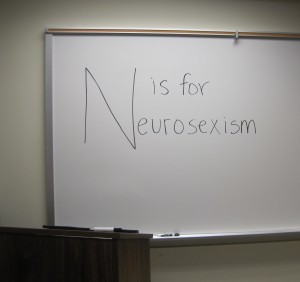Cross-posted from The Neuroethics Blog (Emory Center for Ethics)
Twenty or thirty years ago, single-sex education for girls was a feminist clause célèbre. However, beginning in the late 1990s and early 2000s, people began to worry that boys were “underperforming” in school and in life (an idea nicknamed “the boys’ crisis” by the popular press). The media framing of the boys’ crisis has been critiqued on a number of fronts – specifically, critics have pointed out that both girls and boys are performing better in school than in the past and that the difference in educational achievement between white and middle-class students and low-income and minority students is far more pronounced than the difference between female and male students (see a 2008 report from the American Association of University Women).
However, despite these critiques, cultural commentators began to advocate for single-sex education in public schools as a solution to the boys’ crisis. Commentators like Michael Gurian (author of Boys and Girls Learn Differently!) and Leonard Sax (founder of the National Association for Single Sex Public Education and author of Why Gender Matters) argued that boys’ and girls’ brains develop differently, so boys and girls should be separated in school and should receive education targeted to their specific neuro-developmental patterns and mental strengths.
The Growth of Single-Sex Education
Apparently, Gurian and Sax were very convincing (and they were peddling what people wanted to hear). In 2006, the U.S. Department of Education relaxed restrictions against single-sex education in public schools. According to estimates, in 2002, only about a dozen public schools were offering single-sex classes. Today, an estimated 500 public schools in the U.S. now offer at least some single-sex classes (public schools are required to allow parents to opt-out of single-sex classes) (AP).
For a recent article, two AP reporters visited classrooms at Middleton Heights Elementary, a public school in Idaho that offers single-sex classes. According to the reporters, “In the single-sex classes, teachers use microphones that allow them to electronically adjust the tone of their voice to match the level that research suggests is best for boys. When preparing for a test, the boys may go for a run, or engage in some other activity, while the girls are more likely to do calming exercises, such as yoga…They learn the same curriculum, they still lunch and play at recess together, but the differences in their learning environments are apparent, from the blue chalkboards in the boy classrooms, to the red paper hearts that decorated the wall of one of the girl’s classrooms.”
Neurosexism and Single-Sex Education
Despite the claims of Gurian and Sax, the neuroscience research simply doesn’t support the idea that boys have one type of brain and neuro-developmental pattern and girls have another type of brain and neuro-developmental pattern and that these two types are so different from each other that it makes sense to segregate boys and girls into different classes.
In her excellent book, Delusions of Gender, Cordelia Fine deconstructs the neuroscience claims made by Gurian, Sax and others in support of single-sex education (see especially Chapter 14). To give just one example from Fine: according to Fine, Sax claims that in boys and young children, emotion is processed in the amygdala with few connections to the cerebral cortex, while in older girls, the amygdala is richly connected to the cerebral cortex. As a result, Sax suggests two different strategies for English teachers: teachers are encouraged to ask older girls to reflect on the feelings and motivations of a story’s protagonist; while Sax writes approvingly of a “boy-friendly” class in which the boys were encouraged to read The Lord of the Flies not with an eye for plot or character development, but so as to be able to construct a map of the island. Yet, according to Fine, Sax’s claims about the lack of connections between the amygdala and the cerebral cortex in boys is based on one small neuro-imaging study in which children started passively at fearful faces (they weren’t asked to talk about what they were feeling and brain activity was not even measured in many of the brain areas involved in emotion and language processing) (Fine 2010 pages 163-164).
Linguistics professor Mark Liberman has also deconstructed a number of Sax’s claims in detail on his blog. Summarizing Sax’s arguments, Liberman writes: “Science is sometimes on his side, sometimes neutral or equivocal, and sometimes against him. He picks the results that fit his agenda, ignoring those that don’t; and all too often, he misunderstands, exaggerates or misrepresents the results that he presents.”
Pushing Back: the American Council for CoEducational Schooling and the American Civil Liberties Union
Recently, a number of academics have begun to push back against the campaign for single-sex education. A group (of mostly psychologists) founded an organization, the American Council for CoEducational Schooling, to advocate for coeducation. In 2011, a number of those involved in the group also published an extensive report on single-sex education in Science (“The Pseudoscienceof Single-Sex Schooling” by Halpern et al.) Recently, two of the co-authors, Rebecca Bigler and Lise Eliot, summarized some of the main points of the report for a blog on the Washington Post. They make five main points: 1) the neuroscience research doesn’t support the claim that boys and girls learn differently; 2) decades of national and international education research has found that single-sex education doesn’t improve educational outcomes; 3) gender segregation increases gender stereotyping and prejudice; 4) children in gender-segregated environments develop increasingly narrow skill sets and interests; and, 5) gender segregation reduces the opportunities for boys and girls to learn from each other. They conclude by stating, “Rather than segregating boys and girls during this important developmental time, schools should take better advantage of coeducation to model the truly egalitarian society that we hope for their future.”
The American Civil Liberties Union (ACLU) has been pushing back against single-sex education for years. In May they launched a campaign called “Teach Kids, Not Stereotypes,” and sent demand letters to school districts in six states insisting that the districts takes steps to end single-sex programs that rely on and promote harmful sex stereotypes.
Call to Action: Neuroscientists and Ethical Responsibility

Co-educational cuteness: school children at the Wilmington Fire Department, DE
Picture by Timothy Wildey
Some neuroscientists are involved with the American Council for CoEducational Schooling – Lise Eliot is a neuroscientist and author of Pink Brain, Blue Brain: How Small Differences Grow into Troublesome Gaps – and What We Can Do About It. But she is the only neuroscientist on the eight member board (the rest are psychologists). I also noticed that there are no neuroscientists on their list of members (again, most appear to be psychologists). No doubt this is because the organization was started by psychologists who naturally reached out to their friends and colleagues. However, I strongly encourage neuroscientists to think about becoming members and getting involved in the organization – on their website, they state, “for information on becoming a member of the American Council of CoEducational Schooling, please e-mail us at membership@coedschools.org.”
Because the push for single-sex education has relied so heavily on the use (and misuse) of neuroscience data, I think neuroscientists have a particular power (and perhaps ethical responsibility?) to influence this debate. In regards to research about the brains of boys and girls, policymakers, the media, and members of the general public are more likely to listen to neuroscientists than to women’s studies scholars (or even psychologists).
In general, I would encourage neuroscientists to consider responsibly engaging with the public and the media about this issue. Or, at least donate to the ACLU.



